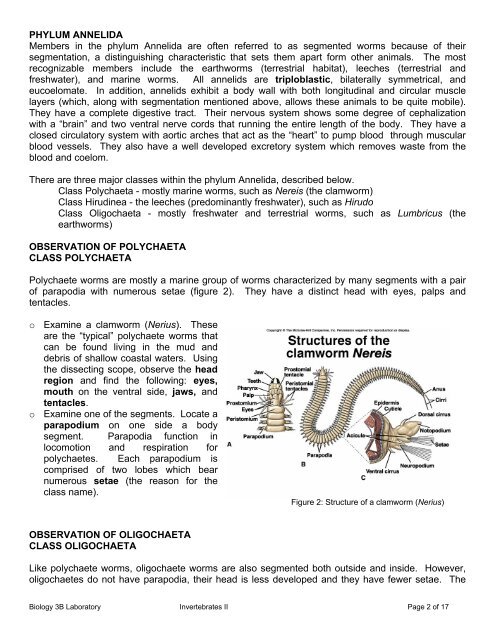Biology 3B Laboratory Invertebrates II: Annelida, Nematoda ...
Biology 3B Laboratory Invertebrates II: Annelida, Nematoda ...
Biology 3B Laboratory Invertebrates II: Annelida, Nematoda ...
Create successful ePaper yourself
Turn your PDF publications into a flip-book with our unique Google optimized e-Paper software.
PHYLUM ANNELIDA<br />
Members in the phylum <strong>Annelida</strong> are often referred to as segmented worms because of their<br />
segmentation, a distinguishing characteristic that sets them apart form other animals. The most<br />
recognizable members include the earthworms (terrestrial habitat), leeches (terrestrial and<br />
freshwater), and marine worms. All annelids are triploblastic, bilaterally symmetrical, and<br />
eucoelomate. In addition, annelids exhibit a body wall with both longitudinal and circular muscle<br />
layers (which, along with segmentation mentioned above, allows these animals to be quite mobile).<br />
They have a complete digestive tract. Their nervous system shows some degree of cephalization<br />
with a “brain” and two ventral nerve cords that running the entire length of the body. They have a<br />
closed circulatory system with aortic arches that act as the “heart” to pump blood through muscular<br />
blood vessels. They also have a well developed excretory system which removes waste from the<br />
blood and coelom.<br />
There are three major classes within the phylum <strong>Annelida</strong>, described below.<br />
Class Polychaeta - mostly marine worms, such as Nereis (the clamworm)<br />
Class Hirudinea - the leeches (predominantly freshwater), such as Hirudo<br />
Class Oligochaeta - mostly freshwater and terrestrial worms, such as Lumbricus (the<br />
earthworms)<br />
OBSERVATION OF POLYCHAETA<br />
CLASS POLYCHAETA<br />
Polychaete worms are mostly a marine group of worms characterized by many segments with a pair<br />
of parapodia with numerous setae (figure 2). They have a distinct head with eyes, palps and<br />
tentacles.<br />
o Examine a clamworm (Nerius). These<br />
are the “typical” polychaete worms that<br />
can be found living in the mud and<br />
debris of shallow coastal waters. Using<br />
the dissecting scope, observe the head<br />
region and find the following: eyes,<br />
mouth on the ventral side, jaws, and<br />
tentacles.<br />
o Examine one of the segments. Locate a<br />
parapodium on one side a body<br />
segment. Parapodia function in<br />
locomotion and respiration for<br />
polychaetes. Each parapodium is<br />
comprised of two lobes which bear<br />
numerous setae (the reason for the<br />
class name).<br />
Figure 2: Structure of a clamworm (Nerius)<br />
OBSERVATION OF OLIGOCHAETA<br />
CLASS OLIGOCHAETA<br />
Like polychaete worms, oligochaete worms are also segmented both outside and inside. However,<br />
oligochaetes do not have parapodia, their head is less developed and they have fewer setae. The<br />
<strong>Biology</strong> <strong>3B</strong> <strong>Laboratory</strong> <strong>Invertebrates</strong> <strong>II</strong> Page 2 of 17

















